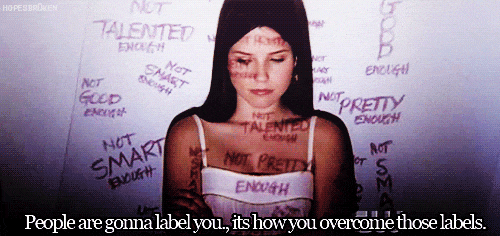In sixth grade, I had a crush on a guy who was in my social studies class and our lockers were near each other (it was alphabetical. My last name starts with M and his started with S) and we would annoy each other constantly. I would pull stupid pranks on him like putting my Jersey Girl magnet from Cape May on his locker while he would push my hand away from my locker dial when I was putting in the combination between classes or "accidentally" bumping into me while walking by me. Being a sensitive, naive 12-year-old girl, I went home to my parents and told them what was happening at school and they smiled and said "That means he likes you. That's his way of flirting with you". Thinking back on these events, I realize that categorizing bad behavior as flirting is basically brainwashing young girls into thinking that it's okay that a boy can hurt them. I don't know how "putting her pigtails in the inkwell" clichè started but it's time for it to end.
1. Love does NOT equal abuse
Love equals kindness and respect and NEVER means touching them in a hurtful way. If you love somebody, you shouldn't touch them at all. Even though I was told that my 6th-grade crush was "flirting" with me by bumping into me on purpose and trying to hurt me, my parents also taught me that a guy should NEVER put his hands on me. If a child constantly hears that somebody that hurts them because that person likes them is connecting love with pain. Instead, we have to teach a child the importance of what love is and what it isn't. Depending on the child's age, try to explain why other children might harm others and how it isn't about liking them - it's about control and getting the upper hand.
2. Kids' friendships shouldn't be romanticized.
Sure everyone has a "boyfriend" or a "girlfriend" while they're in preschool and kindergarten and have innocent crushes on another classmate. Kids need the opportunity to have strong friendships with boys and girls, regardless of their genders, without introducing adult notions of romance and attraction. Being friends with all different genders will help a child in the long run.
3. NEVER victim blame a child who is being picked on
Your child did not ask for this negative attention, regardless of the aggressive kid’s intention. Even if your child was acting flirty or teasing, nobody asks to be hurt. Putting the blame on a child for being hurt tells them that their parents are not a source of support for them when they need them most, and they may not tell their parents when they’re hurt in the future.
4. Dismissing the bad behavior of a bully is a loss-loss situation for both the bully and the victim.
Bad behavior is bad behavior, regardless of the reason why. A child — whether it’s a boy or a girl — who is harming another needs intervention so they don’t continue the behavior. Kids want boundaries, and they need to be taught empathy. Instead of asking the child who is doing the hurting if they like the other, grownups should ask the child to imagine how their friend felt when he or she was hurt. Asking the child to recall the sad face of their friend after they were hurt will help them connect their actions with the resulting pain or sadness, and that’s a very important lesson for kids to learn.











 Photo by
Photo by 








